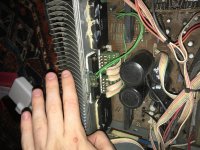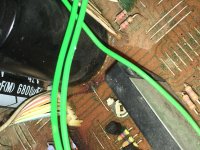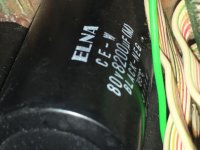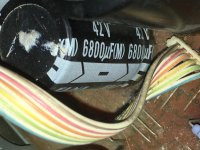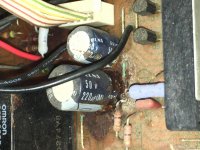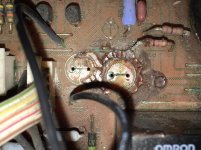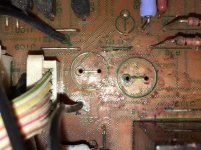Dug out my old kenwood KA828. This was a limited production compact 130w, 450$ new, i guess in the late 80s or early 90s.
The capacitors look kinda leaky, and there seems to be a slight bias issue, with one channel having notably more sustain on the mid-bass.
Would the leakage be the cause of that?
I have no technical knowledge to repair or alter anything on this amplifier, but i know how to solder and can change the capacitors.
Pictures attached. Small capacitors are 25mm width, Large capacitors are 35mm width, there is room at the top of the amplifier to go taller but none to go wider.
Should i just buy the same capacitors, or are there better options?
Does anyone recognise what part of the signal path the final image is from, and whether its worth replacing these also?
Many thanks
Isaac
The capacitors look kinda leaky, and there seems to be a slight bias issue, with one channel having notably more sustain on the mid-bass.
Would the leakage be the cause of that?
I have no technical knowledge to repair or alter anything on this amplifier, but i know how to solder and can change the capacitors.
Pictures attached. Small capacitors are 25mm width, Large capacitors are 35mm width, there is room at the top of the amplifier to go taller but none to go wider.
Should i just buy the same capacitors, or are there better options?
Does anyone recognise what part of the signal path the final image is from, and whether its worth replacing these also?
Many thanks
Isaac
Attachments
In the last picture it looks like the capacitor electrolyte has leaked causing corrosion.
I would remove them, clean up the pcb and replace the capacitors.
Not sure how wise it would be to increase capacitance.
It would make the power up current surge higher too.
Might start blowing fuses.
I would remove them, clean up the pcb and replace the capacitors.
Not sure how wise it would be to increase capacitance.
It would make the power up current surge higher too.
Might start blowing fuses.
What he said^
If you want to investigate further, the manual is here, just have to sign up.
Kenwood KA-828 - Manual - Stereo Integrated Amplifier - HiFi Engine
Maybe some Nichicon FW would be good?
If you want to investigate further, the manual is here, just have to sign up.
Kenwood KA-828 - Manual - Stereo Integrated Amplifier - HiFi Engine
Maybe some Nichicon FW would be good?
Last edited:
In the last picture it looks like the capacitor electrolyte has leaked causing corrosion.
Thanks! You don't think the bigger capacitors look leaky? Maybe its just glue?
Maybe some Nichicon FW would be good?
I bought 2x 220uf KZ nichicon for the ones that look particularly bad. Hopefully doubling the size of the 100uf isnt a problem.
I looked at the serv ice manual for a while but i still have no clue what part of the circuit they are for.
Although I have encountered similar problems with Elna capacitors, these pictures are making me disappointed. This is primarily not due to age and wear, but poor quality.
They are power supply capacitors. I would replace the big ones with fresh ones from a different well-known manufacturer, the same voltage rating, but the largest capacitance there is room for. It cannot possibly be too large.
They are power supply capacitors. I would replace the big ones with fresh ones from a different well-known manufacturer, the same voltage rating, but the largest capacitance there is room for. It cannot possibly be too large.
Caps can be too large. See post 2. In some cases you could get extra ground buzz too. Depends on exactly how good their grounding arrangements are.
Without wanting to sound harsh, the whole unit looks in less than great shape tbh. Those unique hybrid output modules could become an issue if one were to fail or some mishap caused failure.
I think a lot of what you are seeing is in fact glue, and often this glue could be hygroscopic attracting moisture.
It could make an interesting restoration project but I suspect for long term satisfaction you need to look beyond replacing a few caps in hope. If I had that in front of me I would strip the chassis bare and wash all the PCB's but you need the experience of what to wet and what not to wet so probably not a good idea if you are unfamiliar with circuitry in general.
I think a lot of what you are seeing is in fact glue, and often this glue could be hygroscopic attracting moisture.
It could make an interesting restoration project but I suspect for long term satisfaction you need to look beyond replacing a few caps in hope. If I had that in front of me I would strip the chassis bare and wash all the PCB's but you need the experience of what to wet and what not to wet so probably not a good idea if you are unfamiliar with circuitry in general.
- yes, there is some corosion, but it can be from glue, not from leaking electrolyte.In the last picture it looks like the capacitor electrolyte has leaked causing corrosion.
I would remove them, clean up the pcb and replace the capacitors.
.
And yes, despite of the reason it caused, I think it neads to be cleaned and repaired.
Caps can be too large. See post 2. In some cases you could get extra ground buzz too. Depends on exactly how good their grounding arrangements are.
pretty well grounded as per: "elimination of internal ground loops and common ground impedances through extensive use of one-point grounding within the amplifier's key circuit blocks"
so you're saying that could mask capacitor issues? I've identified the really bad looking capacitor as the supply for the preamp rails, so definitely a priority.
Mooly and Vovk, the unit does sound incredible already. Lowest noise floor i've ever heard and a lot of energy and colour. Would be too worried about causing more damage or botching reassembly to go much deeper. What are the benefits of cleaning? I sweeped up and it looks a lot better now, but for sure it wasn't kept dry its entire life.
Good to know about the glue reacting with moisture, makes a lot of sense.
I like things to look pristine if possible... so I suppose satisfaction is major benefit. On a practical level, dust and grime can only attract more of the same and could even be hygroscopic/corrosive over the long term.
Post #10 here:
Washing an amplifier board
Post #10 here:
Washing an amplifier board
I have heard a real story about " hot melt filler" (I dont know exact name) which started to make problems after long period of life. If I am not wrong - it was a video story on Eevblog, repair video from Dave.
Time (tens of years) and humidity make substance to be chemically active, and do things like on the photo. It caused misfunction of device, corrosion "ate" the printed wires.
Time (tens of years) and humidity make substance to be chemically active, and do things like on the photo. It caused misfunction of device, corrosion "ate" the printed wires.
Last edited:
I have heard a real story about " hot melt filler" (I dont know exact name) which started to make problems after long period of life. If I am not wrong - it was a video story on Eevblog, repair video from Dave.
Time (tens of years) and humidity make substance to be chemically active, and do things like on the photo. It caused misfunction of device, corrosion "ate" the printed wires.
Thanks, i think i found it. Is glue really necessary for these capacitors? Are the legs not enough to support them alone, perhaps with a cable tie around them?
If I were in your case and had 'no clue' about what each part is for, I'd better stay with the original values.
And I'd also replace each component (including the jumpers) that shows signs of corrosion.
Best regards!
And I'd also replace each component (including the jumpers) that shows signs of corrosion.
Best regards!
I'm not shure, but I think if you are not going to move or to transport it, if it stay in one place, without move or vibration - legs are enought.Thanks, i think i found it. Is glue really necessary for these capacitors? Are the legs not enough to support them alone, perhaps with a cable tie around them?
Glue is nesesary for manufacturer, because he don't know how long road the device will have.
When device is in the end of his path - in the home of his owner - here it is better conditions and it don't need so strict support and so on.
There are a lot of diy-devices which live long happy life in their makers home.
(And only if you are going to make device to share it with other people - you have to think about a glue for massive components an so on).
Last edited:
As a whole, every electrolytic capacitor that is 20 years old or more, should be considered for replacement. Also, an hour rating better than the usual 1,000 hr rating can be a better decision. Along with that, I like to try and get a 105C heat rating rather than the usual 85C heat rating. Beyond that, there are reasons for so many different cap models. Some work best in power supplies, other work best in audio circuits, yet others are designed for rough service, and on it goes.
Then leave as is, close the cover and enjoy.the unit does sound incredible already. Lowest noise floor i've ever heard and a lot of energy and colour.
Then leave as is, close the cover and enjoy.
oops, too late..
small caps off and then the same but cleaned below. will check corroded resistor and jumper spec tomorrow when i have a multimeter.
Attachments
- if he haven't seen it (corrosion) - he could enjoy. But now - I don't think so 🙂. He can't "un-see" that picture, and that fact will ruine the sound and the fun (inside our brain).Then leave as is, close the cover and enjoy.
I bought a cheap capacitance - inductance meter off eBay.
I had it checked and the capacitance was about 7% wrong.
But it still allows you to easily check if the pulled caps were functioning or had failed.
I also use it to check speaker crossovers ( I have to remember to multiply the capacitance reading by 1.07 but if I do it is accurate)
Failures are rare but they do happen.
I had it checked and the capacitance was about 7% wrong.
But it still allows you to easily check if the pulled caps were functioning or had failed.
I also use it to check speaker crossovers ( I have to remember to multiply the capacitance reading by 1.07 but if I do it is accurate)
Failures are rare but they do happen.
- Status
- Not open for further replies.
- Home
- Design & Build
- Parts
- What to replace these capacitors with?
